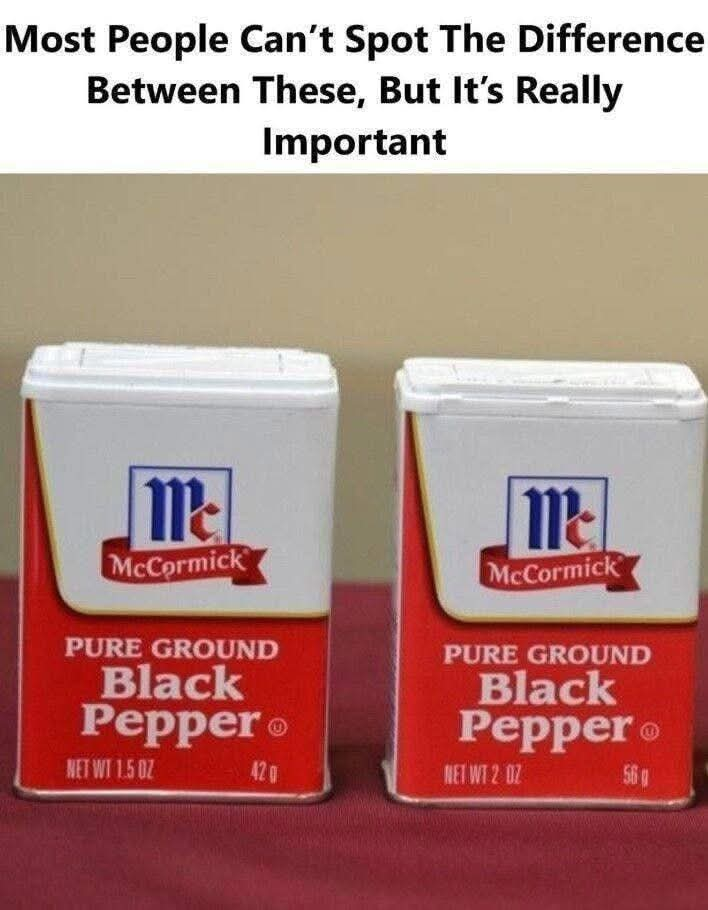Shrinkflation and Food Packaging Tricks: How to Spot Hidden Differences and Save Money
Introduction
Shrinkflation is a quiet but powerful way companies adjust to rising production costs without shocking consumers with higher price tags. Instead of charging more, they give you less for the same price — a smaller bag of chips, a thinner roll of toilet paper, or, in this case, a tin of black pepper that looks the same but contains less. This subtle change can go unnoticed, but over time, it impacts your budget significantly.
Origin and Cultural Significance
The term “shrinkflation” was coined in the early 2010s by British economist Pippa Malmgren, combining “shrink” and “inflation.” It became a widely recognized phenomenon as companies sought creative ways to manage supply chain costs, especially during times of economic pressure. In today’s world of rising food prices, shrinkflation has become part of everyday consumer conversation — a cultural marker of our relationship with grocery shopping and cost-conscious living.
Ingredients Quantity (or Key Example)
- Example Product: McCormick Pure Ground Black Pepper
- Option A: 1.5 oz (42 g) tin
- Option B: 2 oz (56 g) tin
(Both look nearly identical, but one gives you 25% less product for a nearly identical price.)
Optional Additions (Other Examples of Shrinkflation)
- Cereal boxes with more air space and fewer ounces inside
- Ice cream tubs that went from 64 oz to 48 oz
- Snack bags with the same size packaging but fewer chips
- Toilet paper rolls with fewer sheets but same roll diameter
- Candy bars that are slightly smaller but still look similar in wrappers
Tips for Success (How to Outsmart Shrinkflation)
- Always check net weight/volume on the package before buying.
- Compare unit price (price per ounce, per gram, per sheet) — usually shown on store shelves.
- Stock up on bulk sizes when they’re genuinely cheaper per unit.
- Keep track of product sizes you buy often, so you notice when they shrink.
- Don’t be fooled by “new look, same great taste” labels — often they mean smaller quantity.
Instructions (Consumer Action Plan)
- Examine packaging carefully before purchasing — check the weight, volume, or sheet count.
- Compare brands and sizes — sometimes the store brand offers better value.
- Track price per unit — use your phone’s calculator if needed to confirm which option is cheaper.
- Buy strategically — larger packs may save money if you use the product often.
- Report patterns — share shrinkflation examples on social media or with consumer groups to raise awareness.
Description
Shrinkflation is often invisible at first glance — same box, same colors, same marketing slogans — but it quietly chips away at the value you receive. A keen shopper learns to look beyond the surface, reading labels and unit pricing to make sure every dollar stretches as far as possible.
Nutritional Information
(Not applicable — this topic deals with product size and value rather than nutrition. However, it is worth noting that smaller package sizes may encourage portion control for high-calorie snacks, which could have a side benefit for health-conscious consumers.)
Conclusion
Shrinkflation is here to stay, but it doesn’t have to catch you off guard. By becoming an informed shopper and paying attention to packaging details, you can make better purchasing decisions and protect your grocery budget.
Recommendation
Stay vigilant when shopping. Develop a habit of comparing unit prices and paying attention to net weights or volumes — that’s where the real value lies. Keep a mental note of your favorite products’ original sizes so you can spot subtle changes quickly.
Embracing Healthful Indulgence
While shrinkflation can feel frustrating, it can also be reframed as an opportunity to practice mindful consumption. If snack portions are getting smaller, consider it a nudge toward moderation and balance. You can also focus on buying whole, unprocessed foods (like bulk spices, beans, and grains), which tend to be more transparent in pricing and quantity — giving you both value and better nutrition.
Would you like me to turn this into a short printable guide or infographic for quick reference while grocery shopping?

